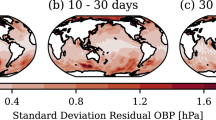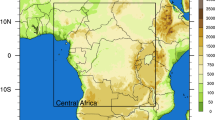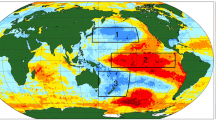Abstract
The analysis of asymmetry of probability distribution functions (PDF) is carried out for key atmospheric variables using the JRA-55 reanalysis data in the troposphere of the Northern Hemisphere for 1976–2014. The nonzero asymmetry of the PDF indicates the deviation of the PDF from the normal distribution. The analysis was carried out for two time-scale intervals: synoptic variability (SV) of 2–7 days and low-frequency variability (LV) of 9–30 days. Statistically significant deviations from the normal probability distribution occur in the regions of the most frequent formation of atmospheric baroclinic perturbations, i.e., over the western parts of the oceans in midlatitudes and downstream in the atmosphere. In the SV time-scale interval, a negative asymmetry of the vertical velocity is revealed in isobaric coordinates for the entire thickness of the free troposphere, which agrees with the overall dominance of cyclonic anomalies in this interval of time scales. In the LV interval, the asymmetry of this variable in the entire free troposphere is positive, which indicates the dominance of anticyclonic anomalies at these time scales. For the zonal velocity, temperature, and geopotential, the asymmetry sign of the PDF for variability with time scales of 2–7 days is different for the upper and lower free troposphere. The asymmetry of the PDF for atmospheric variables indicates the important role of the intermode interaction in the formation of baroclinic perturbations. The corresponding deviations of synoptic variability from the normal distribution, which is found in the upper troposphere of the subpolar and polar latitudes, can be related to the interaction of these perturbations with the winter polar vortex. These deviations of PDF from the normal distribution substantially increase the probability of the appearance of large (in absolute value) anomalies as compared to the case of the Gaussian PDF.
Similar content being viewed by others

References
J. G. Charney, “The dynamics of long waves in a baroclinic westerly current,” J. Meteorol. 4 (5), 135–162 (1947).
E. T. Eady, “Long waves and cyclone waves,” Tellus 1 (3), 33–52 (1949).
M. V. Kalashnik, “Resonant and quasi-resonant excitation of baroclinic waves in the Eady model,” Izv., Atmos. Ocean. Phys. 51 (6), 576–584 (2015).
E. B. Gledzer, F. V. Dolzhanskii, and A. M. Obukhov, Hydrodynamic-Type Systems and Their Application (Nauka, Moscow, 1981) [In Russian].
B. F. Farrell, “The initial growth of disturbances in a baroclinic flow,” J. Atmos. Sci. 39 (8), 1663–1686 (1982).
A. S. Monin, Introduction to Climate Theory (Gidrometeoizdat, Leningrad, 1982) [In Russian].
Akperov M.G., Bardin M.Yu., Volodin E.M. i dr. “Probability distributions for cyclones and anticyclones from the NCEP/NCAR reanalysis data and the INM RAS climate model,” Izv., Atmos. Ocean. Phys. 43 (6), 705–712 (2007).
G. S. Golitsyn, I. I. Mokhov, M. G. Akperov, et al., “Distribution functions of probabilities of cyclones and anticyclones from 1952 to 2000: An instrument for the determination of global climate variations,” Dokl. Earth Sci. 413 (2), 324–326 (2007).
V. Petoukhov, A. V. Eliseev, R. Klein, et al., “On statistics of the free-troposphere synoptic component: An evaluation of skewnesses and mixed third-order moments contribution to the synoptic dynamics and fluxes of heat and humidity,” Tellus A 60 (1), 11–31 (2008).
M. L. Blackmon, J. M. Wallace, N.-C. Lau, et al., “An observational study of the Northern Hemisphere wintertime circulation,” J. Atmos. Sci. 34 (7), 1040–1053 (1977).
M. L. Blackmon, Y-H. Lee, and J. M. Wallace, “Horizontal structure of 500 mb height fluctuations with long, intermediate and short time scales,” J. Atmos. Sci. 41 (6), 961–980 (1984).
M. Perron and P. Sura, “Climatology of non-Gaussian atmospheric statistics,” J. Clim. 26 (3), 1063–1083 (2013).
I. I. Mokhov, M. G. Akperov, and M. A. Prokof’eva, “Cyclone–anticyclone asymmetry in the atmosphere of the extratropical latitudes of the Northern Hemisphere,” Dokl. Earth Sci. 462 (2), 653–656 (2015).
M. Holzer, “Asymmetric geopotential height fluctuations from symmetric winds,” J. Atmos. Sci. 53 (10), 1361–1379 (1996).
S. Kobayashi, Y. Ota, Y. Harada, et al., “The JRA-55 reanalysis: General specifications and basic characteristics,” J. Meteorol. Soc. Jpn. 93 (1), 5–48 (2015).
M. Christoph, U. Ulbrich, and U. Haak, “Faster determination of the intraseasonal variability of storm tracks using Murakami’s recursive filter,” Mon. Weather Rev. 123 (2), 578–581 (1995).
M. Murakami, “Large-scale aspects of deep convective activity over the GATE Area,” Mon. Weather Rev. 107 (8), 994–1013 (1979).
B. J. Hoskins and K. I. Hodges, “New perspectives on the Northern Hemisphere winter storm tracks,” J. Atmos. Sci. 59 (6), 1041–1061 (2002).
I. I. Mokhov and V. K. Petukhov, “Blockings and the tendencies toward their variation,” Dokl. Earth Sci. 357 (9), 1386–1388 (1997).
A. R. Lupo, R. J. Oglesby, and I. I. Mokhov, “Climatological features of blocking anticyclones: A study of Northern Hemisphere CCM1 model blocking events in present-day and double CO2 concentration atmospheres,” Clim. Dyn. 13 (3), 181–195 (1997).
D. Barriopedro, R. Garcia-Herrera, A. R. Lupo, et al., “A climatology of Northern Hemisphere blocking,” J. Clim. 19 (5), 1042–1063 (2006).
A. R. Lupo, I. I. Mokhov, S. I. Dostoglou, et al., “Assessment of the impact of the planetary scale on the decay of blocking and the use of phase diagrams and enstrophy as a diagnostic,” Izv., Atmos. Ocean. Phys. 43 (1), 45–51 (2007).
I. I. Mokhov, M. G. Akperov, M. A. Prokofyeva, et al., “Blockings in the Northern Hemisphere and Euro–Atlantic region: Estimates of changes from reanalysis data and model simulations,” Dokl. Earth Sci. 449 (2), 430–433 (2013).
I. I. Mokhov, A. V. Timazhev, and A. R. Lupo, “Changes in Atmospheric Blocking Characteristics within Euro-Atlantic Region and Northern Hemisphere As a Whole in the 21st Century from Model Simulations Using RCP Anthropogenic Scenarios,” Glob. Planet. Change 122, 265–270 (2014).
I. I. Mokhov and A. V. Timazhev, “Model assessment of possible changes of atmospheric blockings in the Northern Hemisphere under RCP scenarios of anthropogenic forcings,” Dokl. Earth Sci. 460 (1), 63–67 (2015).
V. Ventura, C. J. Paciorek, and J. S. Risbey, “Controlling the proportion of falsely rejected hypotheses when conducting multiple tests with climatological data,” J. Clim. 17 (22), 4343–4356 (2004).
M. Kendall, and A. Stuart, The Advanced Theory of Statistics, Vol. 1: Distribution Theory (Charles Griffin, London, 1963; Nauka, Moscow, 1966).
B. J. Hoskins, I. N. James, and G. H. White, “The shape, propagation and mean-flow interaction of largescale weather systems,” J. Atmos. Sci. 40 (7), 1595–1612 (1983).
J. G. Charney and J. G. DeVore, “Multiple flow equilibria in the atmosphere and blocking,” J. Atmos. Sci. 36 (7), 1205–1216 (1979).
R. Buizza and T. N. Palmer, “The singular-vector structure of the atmospheric global circulation,” J. Atmos. Sci. 52 (9), 1434–1456 (1995).
J. M. Wiedenmann, A. R. Lupo, I. I. Mokhov, et al., “The climatology of blocking anticyclones for the Northern and Southern hemispheres: Block intensity as a diagnostic,” J. Clim. 15 (21), 3459–3473 (2002).
A. H. Monahan, “The probability distribution of sea surface wind speeds. Part I: Theory and SeaWinds Observations,” J. Clim. 19 (4), 497–520 (2006).
Author information
Authors and Affiliations
Corresponding author
Additional information
Original Russian Text © S.V. Loginov, A.V. Eliseev, I.I. Mokhov, 2017, published in Izvestiya Rossiiskoi Akademii Nauk, Fizika Atmosfery i Okeana, 2017, Vol. 53, No. 3, pp. 307–317.
Rights and permissions
About this article
Cite this article
Loginov, S.V., Eliseev, A.V. & Mokhov, I.I. Impact of non-Gaussian statistics of atmospheric variables on extreme intramonth anomalies. Izv. Atmos. Ocean. Phys. 53, 269–278 (2017). https://doi.org/10.1134/S0001433817030070
Received:
Accepted:
Published:
Issue Date:
DOI: https://doi.org/10.1134/S0001433817030070



